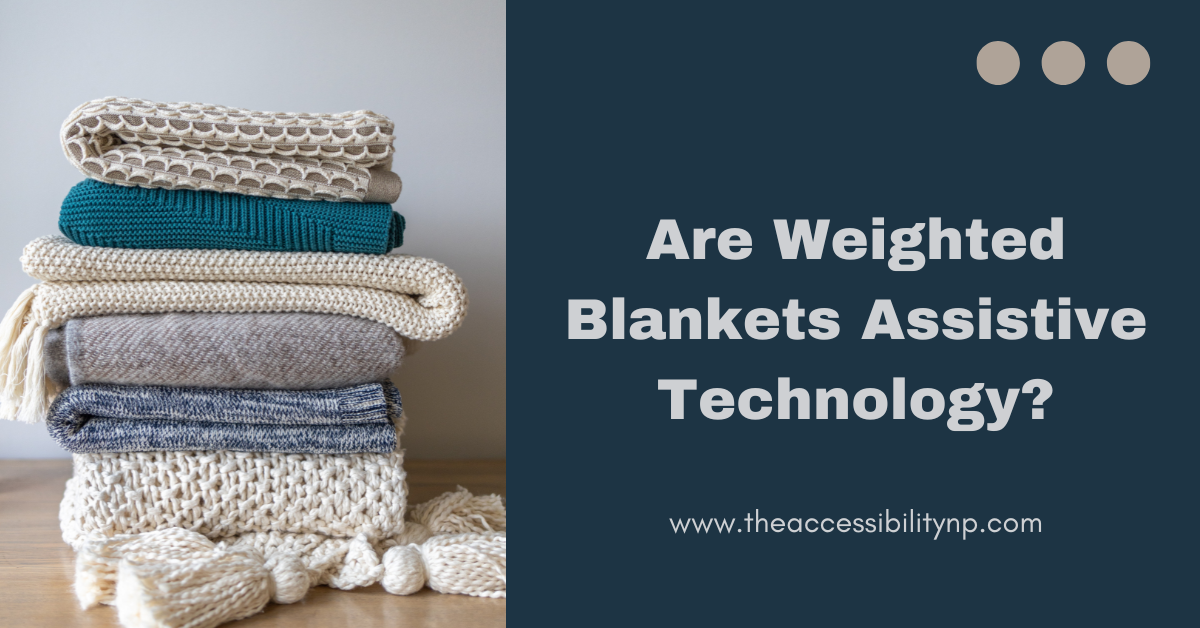If you’ve ever used a weighted blanket, you know how comforting it can feel—the deep, gentle pressure that seems to melt away stress and make relaxation easier. But have you ever thought about whether it’s more than just a cozy comfort item? Can a weighted blanket be considered assistive technology (AT)?
The short answer: Yes, it can! Weighted blankets serve an important role in sensory regulation, making them a form of low-tech assistive technology for individuals who benefit from deep pressure input. While we often think of AT as high-tech tools like speech-to-text software or AAC devices, assistive technology can also include simple, everyday tools that help people function better in their environment.
What is Assistive Technology?
Assistive technology is any device or tool that helps a person perform a task more easily or access their environment more effectively. It can be as advanced as a computer-controlled wheelchair or as simple as a pencil grip. AT is all about supporting individual needs, whether that means improving mobility, communication, or sensory processing.
So, where do weighted blankets fit in?
How Weighted Blankets Support Sensory Regulation
Weighted blankets provide a type of sensory input called deep pressure stimulation (DPS). This is the same kind of pressure you might experience during a firm hug, a massage, or even when a pet rests on your lap. Deep pressure input can have a calming effect on the nervous system, which is why weighted blankets are commonly used by:
- Autistic individuals who experience sensory overload and benefit from grounding input
- People with ADHD who find deep pressure helps with body awareness and relaxation
- Those with anxiety or PTSD who use deep pressure to reduce fight-or-flight responses
- Children and adults with sensory processing differences who need external regulation
- Anyone struggling with sleep who benefits from the serotonin and melatonin boost that deep pressure can provide
When a person wraps themselves in a weighted blanket, it activates the parasympathetic nervous system—the part of our body responsible for relaxation. This can help reduce heart rate, lower cortisol levels (the stress hormone), and promote a sense of calm.
That’s why weighted blankets are often recommended by occupational therapists and sensory specialists as a self-regulation tool. For many individuals, they’re more than just cozy—they provide access to comfort, focus, and rest in a way that traditional blankets don’t.
Weighted Blankets as Low-Tech Assistive Technology
Because weighted blankets enhance accessibility and function, they fit within the category of low-tech assistive technology. Low-tech AT includes tools that don’t rely on electronics or software but still help individuals navigate daily life more effectively.
Examples of low-tech AT include:
- Noise-canceling headphones for individuals sensitive to sound
- Chewable jewelry for those who need oral sensory input
- Adaptive seating for people who require postural support
- Fidget tools to support focus and self-regulation
Like these tools, a weighted blanket provides a specific sensory function that helps individuals regulate their bodies and emotions. It’s not just about comfort—it’s about supporting self-regulation, improving sleep, and making daily life more manageable.
Do Weighted Blankets Work for Everyone?
Not necessarily! While many people benefit from deep pressure input, some find weighted blankets uncomfortable or even overwhelming. Sensory needs are highly individualized, which is why personalized assessments and trials can be helpful.
Some factors to consider when choosing a weighted blanket:
- Weight: Experts often recommend a blanket that is 10% of the person’s body weight, but this varies based on individual preference.
- Material: Some people prefer softer fabrics, while others might need cooling materials if they overheat easily.
- Size: The blanket should cover the individual comfortably without restricting movement.
- Sensory preferences: Some people love deep pressure, while others may find it too intense.
For children, therapists often recommend trying a weighted lap pad or vest first before committing to a full-sized weighted blanket. This allows them to experience deep pressure in smaller doses and decide if it’s beneficial.
The Science Behind Weighted Blankets
Weighted blankets have gained popularity in recent years, and research continues to explore their benefits. While they are not a cure for anxiety, ADHD, or sleep disorders, studies suggest they can be a helpful tool for managing stress and improving sleep quality.
One study published in the Journal of Clinical Sleep Medicine found that individuals with insomnia who used a weighted blanket experienced improved sleep quality, reduced nighttime movements, and felt more refreshed upon waking.
Another study indicated that weighted blankets might help reduce anxiety and improve sleep quality by providing deep pressure stimulation, which has a calming effect on the nervous system.
However, researchers emphasize that while weighted blankets can be a valuable tool, they should be used alongside other personalized strategies for regulation and well-being.
The Takeaway: More Than Just a Blanket
So, is a weighted blanket assistive technology? Yes, when used as a tool for sensory regulation, anxiety reduction, or sleep support, it absolutely qualifies as low-tech AT.
While it’s not the right fit for everyone, many individuals find that a weighted blanket provides access to rest, focus, and a sense of calm—making it much more than just a cozy addition to the bed.
Whether you use a weighted blanket yourself or are considering one for a loved one, sensory tools like these play an important role in everyday accessibility. Understanding individual needs and exploring different options can help determine if this type of tool is the right fit.
Learn More
If you’re interested in exploring more sensory-friendly tools or assistive technology options, consider consulting with an occupational therapist or a sensory specialist who can offer personalized recommendations.
Disclaimer: This post is for informational purposes only and should not be considered medical advice. If you or your child have specific sensory needs, consult with a healthcare provider or occupational therapist before using a weighted blanket.
Sources
-
- American Academy of Sleep Medicine. (2020). Study shows weighted blankets can decrease insomnia severity. Retrieved from https://aasm.org/study-shows-weighted-blankets-can-decrease-insomnia-severity/
- Mayo Clinic. (2022). How weighted blankets may lift anxiety. Retrieved from https://newsnetwork.mayoclinic.org/discussion/mayo-clinic-minute-how-weighted-blankets-may-lift-anxiety/
- Grandin, T. (1992). Calming effects of deep touch pressure in children with autism, college students, and animals. Journal of Child and Adolescent Psychopharmacology. Retrieved from https://www.liebertpub.com/doi/10.1089/cap.1992.2.63

